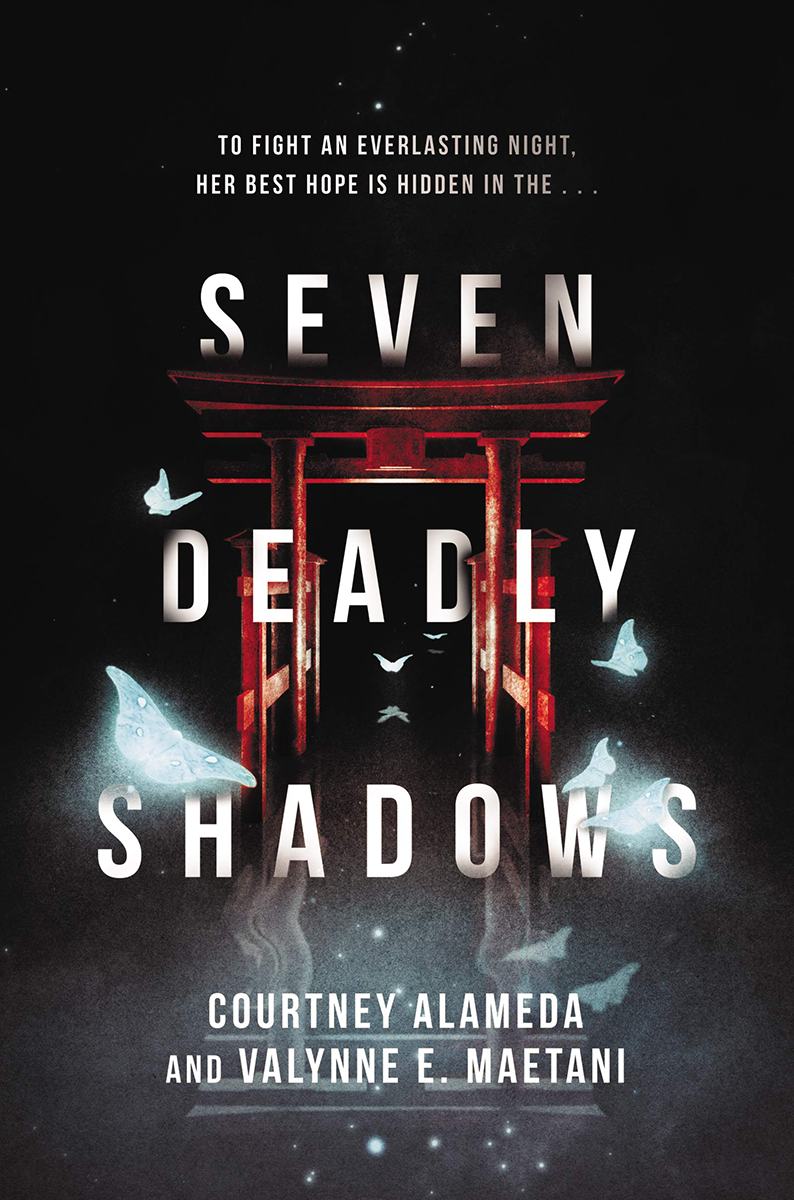Happy Thursday and welcome to my stop on the Seven Deadly Shadows blog tour!! I’m so excited to be on this tour, and I’m even more excited for you to read a deleted scene from the book! Read on to find out more about the book, authors, and tour, plus enter a print copy of Seven Deadly Shadows!!!

 Seven Deadly Shadows by Courtney Alameda, Valynne E. Maetani
Seven Deadly Shadows by Courtney Alameda, Valynne E. Maetani Published on January 28, 2020 by HarperTeen
Genres: YA, Fantasy
Pages: 384
Add to Goodreads
Seventeen-year-old Kira Fujikawa has never had it easy. She’s bullied by the popular girls in school. Her family ignores her. And she’s also plagued with a secret: She can see yokai, the ghosts and demons that haunt the streets of Japan. But things accelerate from bad to worse when she learns that Shuten-doji, the demon king, will rise at the next blood moon to hunt down an ancient relic and bring the world to a catastrophic end.
Not exactly skilled at fighting anything, much less the dead, Kira enlists the aid of seven powerful death gods to help her slay Shuten-doji. They include Shiro, a kitsune with boy-band looks who is more flirtatious than helpful, and O-bei, a regal demon courtesan with covert reasons of her own for getting involved.
As the confrontation with Shuten-doji draws nearer by the day, the fate of Japan hangs in the balance. Can Kira save humankind? Or will the demon king succeed in bringing eternal darkness upon the world?


Hi everyone, Courtney Alameda here! While editing SEVEN DEADLY SHADOWS, we cut a fair number of scenes for time; and while it’s a writer’s job to “murder her darlings,” there was one scene I wish could have remained in the final manuscript:
Meeting Roji.
Please forgive our dust! This scene did not receive editorial treatment (from either the authors or our editor), as it was cut in the second draft. In this scene, Kira has managed to recruit a master shinigami, Shimada, to her cause; but one shinigami alone won’t be enough to stand against the might of a demon horde, so Shimada, Kira, and Shiro travel to the underworld to ask an old friend for help . . .

When we arrive in Harajuku, the snowflakes fall in a fine, sparkling powder. Despite the unseasonable cold, the district’s famous—and most fashionable—Takeshita Street appears to be all dressed up for post-festival nightlife. Butterflies sculpted from balloons adorn the entry arch, and the lights beyond sparkle in pinks, yellows, and purples. The girls on the street are just as kawaii, dressed in cupcake skirts, platform heels, and parasols in a wash of pastels. Kawaii means cute, but it means something more than that, too—the essence of kawaii is happiness and peace. Kawaii girls and boys dress artfully to bring joy to others. I’d be lying if I said the culture didn’t appeal to me . . . it’s just so far removed from my reality. I couldn’t imagine being in that crowd, wearing a pink lolita dress with mounds of lace.
No. My path lies a step deeper into the darkness, alongside a death god.
Amid the mass of people, I spot a strange ogre yokai: horns the color and texture of old toenails curl from his forehead, his demon’s skin tinged faintly blue. He’s not wearing a glamour, but he can fit in during a festival without one. I stop, staring at the creature. He stares right back, cackling as he pulls an eyelid down and sticks out his pimply tongue at me.
“How rude,” I say, shooting the yokai a dark glare.
“What’d I do?” Shiro replies, surprised.
“Not you. Do you see that yokai?” I ask, pointing to the blue-skinned creature. “The ogre in the crowd? He keeps looking at me funny.”
“Yeah?” Shiro says, squinting at the yokai.
“Do you think he’s dangerous?” I ask, leaning a little closer to Shiro.
The yokai stumbles away, snatching a cup of beer from a nearby partygoer with a laugh. The liquid sloshes all over his upper arm as he grabs his crotch and begins to dance around.
“I’ll . . . take that as a no,” I say.
“Shuten-doji has many spies,” Shiro says. “Let’s keep an eye out for him.”
Shimada leads us under an archway of orange lanterns, and then down a narrow alleyway. We follow him through shifting intersections, losing track of all direction. We pass dumpsters and the drifters curled up beside them; cat fights, and hollowed-out cars. And the graffiti! I swear Harajuku is the only place I’ve ever seen real graffiti in Japan. Trash crunches underfoot, everything from paper scraps, lost phone charms, to hypodermic needles. The alleyways seem to draw the city’s trash into their veins.
I almost trip over my own feet when Shimada suddenly stops.
“Here,” he says, placing his other hand on a concrete wall. The air shimmers. Bright graffiti explodes under his palm, paint rippling up from the concrete surface. When the mural completes itself, it depicts a red torii gate surrounded by demons. The concrete inside the gate cracks, shudders, and collapses, revealing a hidden alley. Bright lights in hazardous colors wash over us. As we step beneath the torii gate mural, a thousand yokai snap into view.
This isn’t just any alley, it’s a vibrant street market. Colorful lanterns bob in the air. Yokai hock their wares from innumerable stalls, which feature a range of products (and smells) that I don’t recognize. I see fruits and vegetables I have no names for, some that pulsate with strange light; angler fish-like creatures laid out on ice; and I have to look away from a display of what appears to be human hearts for sale. We pass a food stall at which a futukuchi-onna feeds both her mouths with rice. The mouth in the back of her head grins at me, and I shudder.
“Where have you brought us?” I ask Shimada.
“The Yomi side of Tokyo,” he replies, frowning at the frog-like kappa who waddles by with a sloshing bin full of fish. “Move quickly and try not to attract attention. Understand?”
We plunge into the market. Shiro grips my jacket’s hood, linking us in the midst of the oppressive crowds. It’s hot, and everywhere I look, someone stares back at me. Some of the creatures look . . . hungry.
At times, the shouting and haggling around us grows so dense and loud, drowning in sound seems like a distinct possibility. We emerge from the market onto a darkened street, and head several blocks in a direction I can’t name.
When Shimada finally stops, we are in front of a brick building. The facade is weathered, the awning tattered, and the door has cracks in several places. A dented roll up garage door sags on our right, rust eating away at its folds.
Overhead, a metallic plaque on the front reads ROJI KATO, WEDDING PLANNER in an elegant brush font. Shimada takes one glance and chuckles before he rings the doorbell. It buzzes. We wait, but nobody answers. He rings again. We wait. After a long pause, Shimada begins to tap the bell repeatedly, bzzt, bzzt, bzzt! until someone yells from the other side:
“Dammit, baka, I am closed—”
The door whips open to reveal a girl who doesn’t appear to much older than seventeen or eighteen; but in Yomi, looks are deceiving. She wears black samurai armor, studded with sharp, silver spikes. Her hair’s short and braided to her scalp, the sinuous braids following the curves of her ears, which have black gauges in the lobes. The armor leaves her arms exposed, allowing me to see the butterfly tattoos beating their wings under her skin. Some of their wingtips lift off her skin, leaving ghostly contrails in their wake.
She lifts the tip of a tanto blade to Shimada’s throat. The metal glows with ghostly light. “You bastard. What are you doing here?”
“I didn’t know your surname was Kato,” the old shinigami says, staring her down as she presses the blade against his flesh.
“It’s not,” she replies. “Signs are expensive, and business isn’t that good.”
Shimada grins. “Are you going to invite us in or slit my throat?”
“Slit your throat? Please. You’d think a death god would have a little more imagination when it came to killing. You know what you are, Shimada? You’re vanilla.” She tches, pulling her blade away, and then turns her gaze on Shiro and I. She gestures at us with an uptick of her head. “Who are these fools?”

Thanks for reading! And should you take the time to listen to Kira’s tale, Valynne and I hope you enjoy it! Just remember, don’t fear the shadows . . .


COURTNEY ALAMEDA
 A veteran bookseller and librarian, Courtney Alameda now spends her days writing thriller and horror novels for young people. Her debut novel, SHUTTER, was nominated for a Bram Stoker award and hailed as a “standout in the genre” by School Library Journal. Her forthcoming novel, PITCH DARK (Spring 2017), is a genre-blending science fiction/horror novel in the vein of Ridley Scott’s 1979 film ALIEN.
A veteran bookseller and librarian, Courtney Alameda now spends her days writing thriller and horror novels for young people. Her debut novel, SHUTTER, was nominated for a Bram Stoker award and hailed as a “standout in the genre” by School Library Journal. Her forthcoming novel, PITCH DARK (Spring 2017), is a genre-blending science fiction/horror novel in the vein of Ridley Scott’s 1979 film ALIEN.
Courtney holds a B.A. in English literature with an emphasis in creative writing. She is represented by the talented John M. Cusick of Folio Literary. A Northern California native, she now resides in Utah with her husband, a legion of books, and a tiny five pound cat with a giant personality.
VALYNNE E. MAETANI
 Valynne E. Maetani (pronounced Vuh-lin Mah-eh-tah-nee) grew up in Utah and obtained a Bachelor’s degree from the University of Pennsylvania. In a former life, she was a project manager and developed educational software for children with learning disabilities. Currently, she is a full-time writer. She is a member of the We Need Diverse Books team and is dedicated to promoting diversity in children’s literature because every child should grow up believing his or her story deserves to be told. Her debut novel, Ink and Ashes, is the winner of the New Visions Award 2013, a Junior Library Guild 2015 selection, and Best Fiction Book in Salt Lake City Weekly’s Best of Utah Arts Award for 2015. She lives in Salt Lake City.
Valynne E. Maetani (pronounced Vuh-lin Mah-eh-tah-nee) grew up in Utah and obtained a Bachelor’s degree from the University of Pennsylvania. In a former life, she was a project manager and developed educational software for children with learning disabilities. Currently, she is a full-time writer. She is a member of the We Need Diverse Books team and is dedicated to promoting diversity in children’s literature because every child should grow up believing his or her story deserves to be told. Her debut novel, Ink and Ashes, is the winner of the New Visions Award 2013, a Junior Library Guild 2015 selection, and Best Fiction Book in Salt Lake City Weekly’s Best of Utah Arts Award for 2015. She lives in Salt Lake City.

Courtney
Website | Goodreads | Twitter | Instagram | Tumblr | Facebook
Valynne
Website | Goodreads | Twitter | Facebook









Leave a Reply